Plant Profiles
Click on the first letter of the common name of the plant you wish more information about.
A | B | C | D | E | F | G | H | I | J | K | L | M | N | O | P | Q | R | S | T | U | V | W | X | Y | Z
C
- Caladium
- Calendula
- California Poppy
- Cassava, Variegated
- Cassia
- Chandelier Plant
- Chickasaw Plum
- China Pink
- Chinese Ground Orchid
- Chinese Wisteria
- Chrysanthemum
- Clivia
- Common Camellia
- Common Mulberry
- Common Sunflower
- Confederate Rose
- Copperleaf Shrub
- Coral Bean
- Coral Honeysuckle
- Crinum
- Cross Vine
- Croton
- Crown of Thorns
- Cyclamen
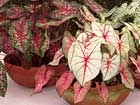
Caladium
Scientific Name: Caladium hortulanum
Growth Habit: An upright to rounded perennial with large heart-shaped leaves rising from below-ground tubers. Plants grow to 18 inches tall from spring through fall and die back to the ground during winter dormancy.
Light: Full sun to shady locations.
Feedings: Apply a light scattering of a general garden fertilizer or manure every 6 to 8 weeks March through September.
Water Needs: Prefers a moist soil; water every 3 to 4 days.
Ease of Culture: Easy.
Propagation: Divide older clumps during February or March.
Hardiness: Hardy; keep mulched to protect tubers from cold.
Major Problems: Slugs feed on the foliage in moist soils, producing large holes in the leaves overnight. Handpick from plants or coax into shallow trays of stale beer. Baits for snails and slugs are also effective. Foliage also may burn if plants are moved from shady sites to sunny locations, but new shoots adjust to the higher light levels.
Pruning: Remove yellowing leaves and old flower heads in late spring and summer.
Uses: Caladiums with brightly colored leaves are the stars of the Florida perennial garden. The foliage is blotched, stripped or spotted with numerous green, red, pink, orange and white patterns. Tubers from the previous year begin growth during March and continue producing foliage through October. Plant in beds, along walkways and in container gardens.
Florida Native: No; hybrids of species from Central and South America.

Calendula
Scientific Name: Calendula officinalis
Growth Habit: A rounded multibranched annual growing to 18 inches tall and wide.
Light: Plant in full sun to light shade.
Feedings: Apply a general garden fertilizer monthly to in-ground plantings; feed container plantings every other week.
Water Needs: Tolerates short periods of drought; water in-ground plantings weekly, container plantings when the surface soil begins to dry.
Ease of Culture: Easy.
Propagation: Start plants from seed.
Hardiness: Hardy.
Major Problems: Roots are affected by nematodes. Plant in gardens that are free of nematodes or grow in containers using a pest-free potting soil. This cool-season annual declines rapidly during the hot spring months.
Pruning: Flowers become unsightly as the petals begin to decline. Remove the faded blooms to keep plantings attractive and to encourage additional buds.
Uses: A colorful cool-season accent, sometimes called the pot marigold, usually planted November through February for flower garden and container displays. The daisylike blooms are available in yellow, orange and light red selections plus varieties with a blend of colors. The blooms are long lasting and often more than 2 inches in diameter. Petals from pesticide-free plantings are edible and often added to salads.
Florida Native: No; native to southern Europe.
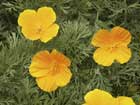
California Poppy
Scientific Name: Eschscholzia californica
Growth Habit: An annual flowering plant with fernlike blue-green leaves growing to 18 inches tall and equally as wide.
Light: Plant in full-sun locations.
Feedings: Apply a general garden fertilizer monthly if needed to encourage growth.
Water Needs: Drought tolerant, but grows best with weekly waterings.
Ease of Culture: Easy.
Propagation: Start seeds during the fall months for spring blooms. Sow seeds directly in the ground. Also may be started in small pots or cell packs to help the young poppies with sensitive roots survive transplanting.
Hardiness: Hardy; tops may be damaged by severe freezes but plant usually grow back from buds near the ground.
Major Problems: Aphids often feed in the tender new shoots. Control as needed with a soap spray; follow label instructions.
Pruning: Plants spread out over the surface of the ground and over the edge of pots. Some light trimming may be needed to keep in bounds.
Uses: Add to the cool-season annual garden. Start plants during the fall to produce growth for flowering March through May. Colors available include orange, yellow, pink, rose and red. Also plant as a temporary ground cover and in containers. Plantings usually regrow from seeds the following year.
Florida Native: No; native to western North America.
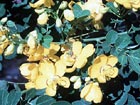
Cassia
Scientific Name: Cassia bicapsularis
Growth Habit: A rounded evergreen shrub with multiple branches growing to 8 feet tall and wide. The leaves grow to 6 inches long and 3 inches wide and are composed of many bright green leaflets.
Light: Plant in full sun to light shade.
Feedings: Apply a general garden fertilizer once monthly in March, June and August if needed to encourage growth.
Water Needs: Drought tolerant; when established, usually survives with seasonal rains.
Ease of Culture: Easy.
Propagation: Start plants from seed.
Hardiness: Medium; damaged by severe freezes but normally grows back from buds near the ground.
Major Problems: Plants are a favorite food of the sulphur butterflies. Most gardeners tolerate the chewing damage caused by the caterpillar stage of the insect and even plant cassia as larva food. Plants may reseed and become a nuisance but can be hand pulled as needed.
Pruning: This shrubby cassia is a bit weak wooded and may need periodic pruning to help reduce growth and keep the plants sturdy and compact. Reserve major pruning until late February at which time cold damage can be removed and the plants can be thinned of lanky shoots and cut back to just a few feet high to resume growth.
Uses: Cassia shrubs invite the butterflies to visit with an abundance of bright yellow flowers during October and November. Plants can be featured as accents near patios or along walkways. They can be used as low view barriers and backdrops for gardens or added to containers for patio or balcony displays.
Florida Native: No; native to the Caribbean.
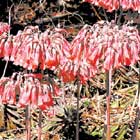
Chandelier Plant
Scientific Name: Kalanchoe delagoensis
Growth Habit: An upright succulent perennial with leaves uniformly spaced around a single stem growing to 3 feet tall. The leaves are lancelike and folded to a canoe shape; they have brownish spots and grow to 8 inches long and 1 inch wide.
Light: Plant in a full-sun to lightly shaded area.
Feedings: Seldom needed. Apply a light feeding of a general garden fertilizer once monthly in March and June only if needed to encourage growth.
Water Needs: Very drought tolerant; survives with moisture from seasonal rains.
Ease of Culture: Easy.
Propagation: Start plants from cuttings or plantlets that form along the leaves.
Hardiness: Medium; damaged by freezes but grows back from buds near the ground.
Major Problems: Occasionally damaged by slugs and chewing insects, but controls are seldom needed. Grow in a sandy, well-drained soil to avoid root-rot problems.
Pruning: Trim as needed to keep plants in bounds and remove old flower stalks as they decline. Also remove dead and lanky shoots during February before growth begins.
Uses: A colorful plant for the drier poor landscape soils. Plants can be used as ground covers in dry or hard-to-maintain areas. They also can be planted as accents in portions of perennial beds or containers. February through March, clusters of pendulous orange-red flowers open at the top of up-to-3-foot-tall stalks above the foliage. This succulent multiplies quickly and may compete with nearby plantings; control as needed to restrict growth to the desired location.
Florida Native: No; native to Madagascar.
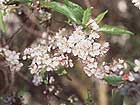
Chickasaw Plum
Scientific Name: Prunus angustifolia
Growth Habit: A small deciduous tree with a rounded shape, often developing more than one trunk and growing to 20 feet tall and wide. The leaves are bright green and lancelike, growing to 3 inches long and 1 inch wide.
Light: Plant in full sun to lightly shaded locations.
Feedings: Apply a general garden fertilizer once each month in March and June for new trees up to three years after planting. After that, additional feedings are normally not needed as older trees obtain nutrients from decomposing mulches or nearby feedings of turf and shrubs.
Water Needs: Drought tolerant. Water until the root systems of new trees become established in the surrounding soil. Seasonal rains normally provide adequate moisture for established trees.
Ease of Culture: Easy.
Propagation: Start plants from seeds or by removal of rooted offshoots.
Hardiness: Hardy.
Major Problems: Eastern tent caterpillars build nests in the trees during later winter. The insects are unsightly and cause only minor damage. If needed, the nests can be cut out or treated with a natural insecticide.
Pruning: Train the plum to a single trunk until more than 4 feet high; then allow branching to create a rounded canopy. Thin out smaller limbs in midwinter just before flowering to keep an open growth habit. Trees commonly send up shoots from their base and root system that should be removed as noted to prevent a thicket of growths.
Uses: A beautiful first of the year accent tree for street, entrance, patio or garden plantings. The white blossoms open in February and are especially appreciated by those who remember the early spring cherry blossoms of the north. Chickasaw plums provide good shade and maybe a few tart but tasty fruits for you and the wildlife.
Florida Native: Yes.
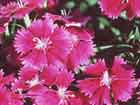
China Pink
Scientific Name: Dianthus chinensis
Growth Habit: An upright perennial, often planted as a garden annual, growing to 18 inches tall and half as wide. The leaves are blue-green and lancelike, growing to a half-inch wide and several inches long.
Light: Plant in full sun to light shade.
Feedings: Apply a general garden fertilizer to in-ground plantings monthly; feed container plantings every other week.
Water Needs: Prefers a moist soil. In-ground plantings grow best with weekly waterings; container plantings may need daily watering during the drier months.
Ease of Culture: Easy.
Propagation: Easy.
Hardiness: Easy.
Major Problems: Caterpillars sometimes feed among the flowers and leaves. Handpick or control with a natural spray as needed. Slugs and snails also may affect the foliage. Handpick or use a snail-and-slug bait as instructed on the label.
Pruning: Breeders have tried to produce plants that naturally hide the declining flowers, but it's probably best to remove them by hand from container plantings to keep them attractive.
Uses: China pinks, commonly referred to by the scientific name dianthus, are best used in clusters as a garden annual or added to containers for color November through May. Flushes of flowers with edges that appear to be trimmed with pinking shears open in red, white and pink colors to cover the tops of the plants. Use in hanging baskets or planters in combination with other seasonal annuals.
Florida Native: No; most are hybrids with relatives from China.
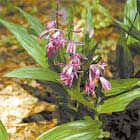
Chinese Ground Orchid
Scientific Name: Bletilla striata
Growth Habit: A terrestrial orchid with broad, lancelike, dark green leaves borne on plants growing to 12 inches tall. Leaves appear before the flowers open during spring and die back by fall.
Light: Plant in a lightly shaded location under a tree, tall shrub or arbor.
Feedings: Fertilize lightly with a general garden product every 6 to 8 weeks March through August.
Water Needs: Prefers a moist soil during periods of above-ground growth. Water at least weekly and maintain a 1- to 2-inch mulch of leaves or compost.
Ease of Culture: Easy.
Propagation: Divide older, well-established clumps; dividing too often delays flowering.
Hardiness: Hardy.
Major Problems: Plantings need adequate moisture but a well-drained soil. Wet soils can cause root rot and plant decline.
Pruning: Gardeners can remove old flower stalks after the blooms fade and declining stems during fall to maintain attractive beds.
Uses: The Chinese ground orchid thrives in lightly shaded sites and flourishes in a moist soil. This true orchid has stalks of 1- to 2-inch purplish flowers produced above the foliage during March and April. Plant as a ground cover for the spring blossoms and green foliage during the summer. Plant in containers for patios, porches and balconies. A white variety is also available.
Florida Native: No; native to China and Japan.
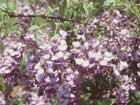
Chinese Wisteria
Scientific Name: Wisteria sinensis
Growth Habit: A deciduous vine with twining shoots growing to more than 40 feet long. The leaves are composed of seven to 13 leaflets, are bright green and grow to 6 inches wide and a foot long.
Light: Tolerates light shade but grows and flowers best in full sun.
Feedings: Fertilize lightly once monthly in March and June with a low-nitrogen general garden product often sold as a blossom booster. Overfeeding encourages excessive vining and fewer flowers.
Water Needs: Drought tolerant; keep moist until the roots of new plants grow into the surrounding soil. Thereafter plants usually exist with moisture from seasonal rains.
Ease of Culture: Easy.
Propagation: Start vines from seeds or cuttings.
Hardiness: Hardy.
Major Problems: Thrips and mites may cause the flowers and foliage to turn brown, but they are considered minor pests that seldom need control. Vining shoots can climb trees to compete for foliage sites. Restrict vines to landscape structures to prevent tree decline.
Pruning: Prune after flowering and periodically during the summer months to restrict growth. Discontinue pruning by late summer to allow the stems to form flower buds. Plants can also be trimmed to create a free-standing shrub.
Uses: An attractive accent vine to conceal a wall or a fence, climb a trellis or cover an arbor. Plants are often featured near a home or a patio and at the entrance to gardens.
Florida Native: No; native to China.

Chrysanthemum
Scientific Name: Chrysanthemum x morifolium
Growth Habit: Upright clump-forming evergreen perennials growing to 2 feet tall and equally as wide. Produces pleasantly scented deep-cut, dark-green leaves that grow to 2 inches long and equally as wide.
Light: Plant in full-sun to lightly shaded locations.
Feedings: Apply a general garden fertilizer to in-ground plantings once monthly in March, June and August. Feed container plantings every other week March through December.
Water Needs: Tolerates short periods of drought during the cooler months; in-ground plantings grow best with twice-a-week, evenly spaced waterings during periods of growth and flowering. Water container plantings when the surface soil starts to dry.
Ease of Culture: Easy.
Propagation: Start plants from cuttings.
Hardiness: Hardy.
Major Problems: Leaf miners often tunnel between the leaf surfaces causing a blotched look to the foliage; control with a systemic insecticide as needed. Fungal leaf spots produce brown leaves during the summer rainy season; apply a fungicide as needed. Some selections are not suited to Florida conditions and decline after providing a cool-season display.
Pruning: Trim declining flower heads during the fall and winter months to encourage additional blooms. Cut back the plants to within 6 inches of the ground during spring to encourage growth. Trim out the tops as needed spring through summer to encourage branching; complete all trimming by mid-August.
Uses: Chrysanthemums, often called mums, are one of the sure signs fall has arrived. Plants begin blooming during late August and continue through the early spring months, creating mounds of daisylike displays of assorted colors. Add to perennial beds for permanent plantings or use as seasonal flowers for pockets of color throughout the landscape. Mums also are added to planters, dish gardens and pots for fall and winter displays.
Florida Native: No; hybrids with parents from China.
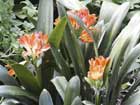
Clivia
Scientific Name: Clivia miniata
Growth Habit: An upright bulblike evergreen perennial related to the amaryllis with leaves originating from tuberous roots forming plants 18 inches tall and wide. The leaves are dark green and lancelike and grow to 18 inches long and 3 inches wide.
Light: Plant in filtered-sun locations.
Feedings: Apply a light application of a general garden fertilizer to in-ground plantings once monthly in April and July. Feed container-grown plants every other week with a half-strength 20-20-20 or similar product April through September.
Water Needs: Prefers a moist soil April through September; water at least weekly. During the fall and winter, seasonal rains provide adequate moisture.
Ease of Culture: Easy.
Propagation: Start plants from seed or by dividing older clumps.
Hardiness: Tender; susceptible to severe freezes but survives most winters with little damage when protected by trees.
Major Problems: Grasshoppers may chew holes in leaves but can be handpicked from the plants as needed. Provide a well-drained soil to prevent root-rot problems during cool, damp weather.
Pruning: Periodically remove declining leaves to keep garden clumps attractive. Also remove old flower heads or seed clusters as needed.
Uses: A special flowering bulb for hobbyists and collectors that's sure to attract attention with its ornamental dark-green foliage and bright-orange flowers. The plants come into bloom, opening clusters of trumpetlike blossoms, after cool, dry weather, normally in late winter or early spring. Most blossoms are orange, but a yellow-flowered form is also available. The plants are best displayed in clusters to form a garden accent, but they also can be spaced along a shaded pathway. Many gardeners like to keep clivia in a container to display on a porch or a patio, where the plants can be given more protection during a severe freeze.
Florida Native: No; native to South Africa.
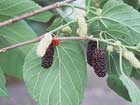
Common Mulberry
Scientific Name: Morus alba
Growth Habit: A deciduous tree with a rounded shape growing to 30 feet tall and wide. The leaves are bright green and variable, ranging from rounded to three-lobed and growing to 6 inches long and wide.
Light: Plant in a full-sun location.
Feedings: Fertilize new trees with a general garden fertilizer once monthly in March and June for the first three years. Thereafter, decomposing mulches and feedings given nearby lawns and ornamentals provide needed nutrients.
Water Needs: Drought tolerant; can usually exist with seasonal rains.
Ease of Culture: Easy.
Propagation: Start trees from seeds or cuttings.
Hardiness: Hardy.
Major Problems: Caterpillars and leaf spot organisms may occasionally affect the foliage but seldom need control. The berries are messy if trees are planted near walkways. They are also a favorite food of birds, which may leave residues on furniture and other outdoor structures.
Pruning: Train trees to a single trunk when young and allow branching to begin when 6 to 8 feet tall. Prune to develop a rounded crown with evenly spaced limbs.
Uses: An excellent addition to the edible landscape; also known as the white mulberry. Trees can be used for shade in natural areas away from patios and walkways. Small white flowers open in February and are followed by the red to black berries that mature in late March and April. The fruits attract wildlife but can also be used fresh or made into pies and preserves. Fruitless selections and a weeping form are also available.
Florida Native: No; native to China.
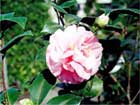
Common Camellia
Scientific Name: Camellia japonica
Growth Habit: An upright to rounded evergreen shrub to small tree growing to 15-feet tall. The leaves are glossy, dark green, elliptic in shape with small-toothed edges and grow to 4 inches long and half as wide.
Light: Plants grow best in partial shade, but many selections tolerate full sun.
Feedings: Apply a general garden fertilizer once monthly in March, June and August.
Water Needs: Prefers a moist soil with weekly waterings, but can tolerate short periods of drought.
Ease of Culture: Easy.
Propagation: Start plants from seeds or cuttings.
Hardiness: Hardy; open flowers may be damaged by freezing weather, but the plants are not affected.
Major Problems: Almost every camellia grower can expect an attack of tea scale, a small brown to white insect that feeds from the undersides of the leaves. Apply an oil spray as needed to maintain control. Poor flowering may result if gardeners do not pick their varieties carefully. Choose types that are labeled early to midseason selections. Also avoid pot-bound plants that never grow out of their root balls.
Pruning: Encourage numerous branches and compact growth by periodically removing the ends of branches during spring. Also remove errant shoots to keep a shapely plant and trim out declining stems to prevent die-back in older plants. Pruning should be stopped by the end of May to allow the plants to form buds for fall and winter color.
Uses: Camellias find many uses including foundation plantings, backdrops for gardens, unclipped hedges and view barriers. They are also used as freestanding accents at entrances, near patios and along walkways. This is one of a few late fall and winter flowering shrubs that can add lots of color to landscapes. Flowers open December through early March.
Florida Native: No; native to Japan and South Korea.
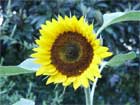
Common Sunflower
Scientific Name: Helianthus annuus
Growth Habit: An upright annual flower growing to more than 10 feet tall depending on the variety. The leaves are bright green and heart-shaped and grow to a foot long and about as wide.
Light: Grows in a full-sun location.
Feedings: Apply a balanced fertilizer monthly until the flowers form.
Water Needs: Prefers a moist soil; add a 2- to 3-inch mulch and water every three to four days.
Ease of Culture: Easy.
Propagation: Start plants from seed.
Hardiness: Tender; severely damaged by frosts.
Major Problems: Caterpillars and grasshoppers often chew holes in the foliage. Control by handpicking or use of a natural insecticide. Beetles and big-legged plant bugs may affect the flowers and can be handpicked to control as needed. Taller plants may need staking to prevent wind damage.
Pruning: Plants grow to a single stem until flowering, when newer selections often branch to open multiple blooms. Varieties with a single large flower head do not need pruning until it's time to remove the seeds or declining stems. Plants forming multiple flower heads can have the faded blooms removed to encourage additional flower clusters.
Uses: Sunflowers form an attractive backdrop for flower gardens and shrub plantings. They also may be planted along walkways and in containers. The colorful sunflower portion is an inflorescence composed of hundreds of blossoms. Most gardeners are familiar with tall-growing sunflowers with the traditional single flower head featuring yellow outer petallike blossoms and yellow to dark central blooms. Newer varieties often open orange, red, bronze or bicolor blossoms. Sunflowers begin flowering about 60 days after planting and can be grown year-round but may be affected by cold during the winter months. Stems of blooms can be cut for flower arrangements or left in the garden to form seeds to harvest or leave for the birds.
Florida Native: No; native to the United States.
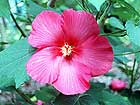
Confederate Rose
Scientific Name: Hibiscus mutabilis
Growth Habit: A semi-evergreen rounded shrub with an open branching habit maintaining limbs to the ground and growing to 8 feet tall and wide. The leaves are heart-shaped, growing to 6 inches long and wide.
Light: Plant in full sun to lightly shaded locations.
Feedings: Apply a general garden fertilizer once each month in March, June and August.
Water Needs: Tolerates short periods of drought; grows and flowers best with weekly waterings.
Ease of Culture: Easy.
Propagation: Start plants from cuttings.
Hardiness: Hardy; damaged by cold and may freeze to the ground but grows back from buds near the soil line.
Major Problems: Plants are a favorite host for whiteflies that cause leaves to yellow and drop. They also may become covered with a black sooty mold because of insect activity. Control whiteflies and sooty mold as needed with a natural oil spray; follow label instructions.
Pruning: Most plantings decline during the winter months and need rejuvenation pruning by February. Remove cold-damaged limbs back to healthy stems or to the ground. Also remove older limbs and reshape plants as needed.
Uses: Plant as an accent feature near patios, along walkways or with other shrubs. Also use as a backdrop for other plantings or as a view barrier during the warmer months. Confederate rose plants, also called cotton rose, open white to pink 6-inch or larger blossoms in the morning that turn a reddish color by the end of the day and decline. This member of the mallow family is related to okra, rose of Sharon and cotton.
Florida Native: No; native to China.
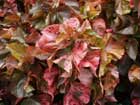
Copperleaf Shrub
Scientific Name: Acalypha wilkesiana
Growth Habit: An upright to rounded evergreen shrub growing 8 feet tall and wide in Central Florida but much larger in more southern locations. The leaves are oval to rounded in shape with green, bronze, red and yellow variations; they grow to 8 inches long and wide.
Light: Plant in a full-sun location.
Feedings: Apply a general garden fertilizer once a month in March, June and September if needed to encourage growth.
Water Needs: Tolerates short periods of drought but grows best with weekly waterings during drought.
Ease of Culture: Easy.
Propagation: Start plants from cuttings.
Hardiness: Tender; damaged by freezes but usually grows back from buds near the ground.
Major Problems: Mealybugs and scale insects may cluster along stems and within the buds to suck plant juices and encourage the growth of sooty mold on the foliage. Use an oil spray for control. Caterpillars are also occasional feeders but seldom need control.
Pruning: Give a renewal pruning in late February to remove cold-damaged shoots and reshape the shrubs. Remove errant shoots at any time to keep plants in bounds and maintain a compact growth habit.
Uses: Create mass plantings of three or more shrubs to form accents that give a year-round burst of color. Plantings also can be used as space dividers and hedges. Many gardeners like to set individual plants in containers to display on the patio, the balcony or at entrances. Several varieties are marketed for their exceptionally colorful foliage. Terminal but usually inconspicuous clusters of yellow to copper-colored flowers also are produced.
Florida Native: No; native to the Pacific Islands.
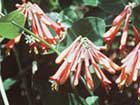
Coral Honeysuckle
Scientific Name: Lonicera sempervirens
Growth Habit: An evergreen vine with entwining shoots that grow 10 to15 feet long. The leaves are oblong, bright green on the top and whitish beneath, growing to 3 inches long and 11/2 inches wide.
Light: Plant in full-sun locations.
Feedings: Fertilize new plants lightly every other month March through September with a general garden product for the first year. Thereafter, plants usually obtain needed nutrients from decomposing mulches and nearby feedings of trees and shrubs.
Water Needs: Drought-tolerant but prefers a moist soil. Grows best with waterings every other week.
Ease of Culture: Easy.
Propagation: Start plants from seeds or cuttings.
Hardiness: Hardy.
Major Problems: Aphids may affect new shoots, and leaf spots can develop during periods of damp weather. The problems seldom need control.
Pruning: Direct growth by trimming stems to cause branching which can fill a trellis or an arbor. Also trim as needed to keep the plants in bounds. Like many vines over time, the lower leaves are lost and most growth is concentrated near the top of the plants. Renewal pruning is needed every few years to encourage new shoots from the base and fuller plants.
Uses: One of Florida's best vines, also known as the trumpet honeysuckle, is used to disguise and accent a wall or to create a colorful view barrier. Avoid sending vines up trees; instead provide a trellis, a fence or an arbor. Clusters of tubular orange to reddish blossoms with contrasting yellow stamens produce major displays in March and April. Plants continue to open sporadic blooms through summer. A yellow-flowered selection is also available.
Florida Native: Yes.
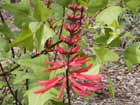
Coral Bean
Scientific Name: Erythrina herbacea
Growth Habit: An open, rounded to sprawling, multibranched deciduous shrub growing to 5 feet tall and wide. The leaves grow to 6 inches long and are bright green with three triangular segments. Leaves and stems have thorns.
Light: Plant in full sun to lightly shaded locations.
Feedings: Feed once monthly in March and June with a general garden fertilizer. Once established, the shrubs can exist with nutrients from decomposing mulches or leaf litter.
Water Needs: Drought tolerant; grows best when watered at least every other week.
Ease of Culture: Easy.
Propagation: Start plants from seed or cuttings.
Hardiness: Medium; often damaged by freezes but grows back from buds near the ground.
Major Problems: Chewing insects occasionally may damage the foliage, but a control seldom is needed.
Pruning: Remove cold damage at the end of February, and reshape to a compact habit of growth. Prune as needed during the growing season to keep the plants in bounds.
Uses: Add to woodland settings with filtered sunlight. Can be planted as an understory shrub that opens bright-red stalks of flowers that attract hummingbirds April through May. Plants can be clustered in open areas as accents along walkways or as a backdrop for flower gardens. Long seedpods are produced during the summer and open by fall to reveal poisonous red seeds.
Florida Native: Yes.
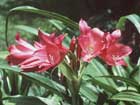
Crinum
Scientific Name: Crinum bulbispermum
Growth Habit: Upright, evergreen perennials grow from bulbs near ground level. The bright green leaves are 5 inches wide and up to 3 feet tall.
Light: Plant in full-sun to lightly shaded locations.
Feedings: Apply a general garden fertilizer in March, June and September.
Water Needs: Tolerates short periods of drought; grows best with weekly waterings.
Ease of Culture: Easy.
Propagation: Start plants from seed or by dividing older clumps.
Hardiness: Hardy; leaves may be damaged by cold, but new growth resumes from the bulbs.
Major Problems: Grasshoppers feed on the large green leaves. The lubber grasshopper is especially attracted to the crinums and is best controlled by hand removal and destroyed. Red blotch, a fungal disease, causes large rusty red spots on the leaves. Affected leaves are best removed as they develop.
Pruning: Most flower heads are removed as the blossoms fade. Also remove declining leaves and those affected by cold as needed.
Uses: Plant crinums in groups for their warm-season flower clusters produced at the top of thick stems. Several species, hybrids and varieties are cultivated in Florida. They open large trumpet- to spider-shaped red, pink or white blossoms April through November. Add crinums to perennial gardens or use as accents among foundation plantings and along walkways. Specimens also can be grown in containers.
Florida Native: No; native to South Africa.
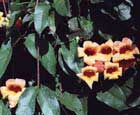
Cross Vine
Scientific Name: Bignonia capreolata
Growth Habit: An evergreen vine with lancelike 2- to 5-inch-long leaves on shoots that can climb to heights of more than 30 feet.
Light: Plant in full-sun to lightly shaded locations.
Feedings: Apply a general garden fertilizer under the spread of the foliage monthly in April and June.
Water Needs: Tolerates short periods of drought; grows best with weekly waterings.
Ease of Culture: Easy.
Propagation: Start new plants from seeds or cuttings.
Hardiness: Hardy.
Major Problems: Caterpillars may feed on the foliage; control seldom is needed.
Pruning: Trimming often is needed to keep the vigorous shoots trained to an arbor or a trellis. Give the vine a major pruning after it flowers during the spring months. Avoid allowing the vine to climb trees and shrubs.
Uses: Cover a wall, a trellis or a patio arbor with the cross vine for summer shade and plenty of late winter and spring color. The clusters of 2-inch-long tubular yellow and orange blossoms begin opening during February and may continue through April. The vine has disk-bearing tendrils that allow it to adhere to wood and masonry without supports.
Florida Native: Yes.
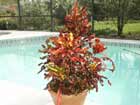
Croton
Scientific Name: Codiaeum variegatum
Growth Habit: Evergreen shrubs upright to rounded in shape growing to10 feet tall and 5 feet wide. The leaves are linear to oval in shape, often lobed and of varying colors.
Light: Plant in full sun to shady locations. Leaf color is best in the higher light levels.
Feedings: Apply a general garden fertilizer once each month in March, June and September.
Water Needs: Tolerates short periods of drought; grows best with weekly waterings.
Ease of Culture: Easy.
Propagation: From cuttings.
Hardiness: Medium; damaged by freezing weather. Plants protected by buildings and trees normally escape major cold injury.
Major Problems: Mites and thrips can cause leaf discoloration and drop. Scale insects and mealybugs also are noted often. All can be controlled with an oil spray as needed following label instructions.
Pruning: Reshape crotons during March by removing cold damage and limbs that have grown out of bounds. Light pruning also may be needed during the growing season to encourage compact, well-branched shrubs. Crotons can be trimmed to a hedge.
Uses: A color-filled shrub to plant as an accent feature anywhere in the landscape. Plantings are especially attractive in the shady locations where flowering plants are not always available. They also can be added to containers for indoor patio displays. The small white flowers are borne on long shoots but are not especially attractive.
Florida Native: No; native to Malaysia.
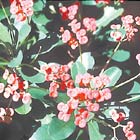
Crown of Thorns
Scientific Name: Euphorbia milii
Growth Habit: A rounded to sprawling evergreen perennial with thorny stems and open-branching habit growing to 2 feet tall and wide. Plants produce only a few leaves, toward the ends of the branches, that grow to 3 inches long and an inch wide.
Light: Plant outdoors in full sun to light shade. Indoors, grow in a bright location.
Feedings: Broadcast a light application of general garden fertilizer on the surface of the soil once monthly in March and June. Feed container plantings with a half-strength 20-20-20 or similar fertilizer every two to three months.
Water Needs: Drought tolerant; outdoor plantings usually receive adequate water from seasonal rains. Indoors or in protected areas, water when the surface soil feels dry.
Ease of Culture: Easy.
Propagation: Start plants from cuttings during the warmer months.
Hardiness: Tender; protect from freezing temperatures.
Major Problems: Plant in well-drained soils to avoid root-rot problems. Plants growing indoors or in areas protected from natural weather conditions may be affected by mealybugs. Control with an oil spray as needed.
Pruning: Slow growing but may spread out to interfere with nearby plantings. Prune unwanted shoots during the warmer months and use as cuttings. Remove dead or declining shoots as needed.
Uses: An ideal accent for dry-land plantings and perennial gardens. The crown of thorns resembles a cactus but is really a poinsettia relative in the Euphorbiaceae family. Many of the introductions are hybrids with colorful red, pink, orange or yellow blossomlike portions. Plants are often grown in containers for indoor or patio displays.
Florida Native: No; native to Madagascar.
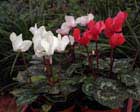
Cyclamen
Scientific Name: Cyclamen persicum
Growth Habit: A perennial growing to 10 inches tall and wide; grows from a tuber. The leaves are dark green to silvery and rounded to heart-shaped.
Light: Grow in a filtered-sun or bright location without direct sunlight.
Feedings: Monthly September through April with a liquid houseplant fertilizer; none during summer.
Water Needs: Moisten when the surface soil begins to dry September through May; then allow the soil to remain dry until growth resumes.
Ease of Culture: Medium; plants often decline during the summer.
Propagation: New plants are started from seeds or tubers.
Hardiness: Tender; protect from temperatures below 40 degrees.
Major Problems: Grows best in a cool climate. Tubers are susceptible to rotting and should be kept dry when the plants rest during late spring and summer.
Pruning: Remove older yellowing leaves and faded flowers as needed. All declining portions should be removed when plants go dormant during the warmer months.
Uses: Cyclamen, with pink, white or red blossoms, can be displayed in the home, on the patio or as a seasonal bedding plant. As cyclamen begins to decline during late spring, allow the soil and tuber to dry; add water as needed to prevent shriveling. Water normally when growth resumes in the fall. Saved plants re-bloom in early spring.
Florida Native: No; native to the Mediterranean region.

